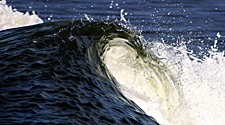
With global attention focussing on climate change and the rising level of atmospheric CO2, efforts to generate electricity from renewable sources are an important area of research. Ocean waves represent a potentially vast source of renewable energy, with coastal waves estimated to generate about 1 TW globally. The potential for capturing this energy from waves is considerable.
There are various designs of Wave Energy Converter (WEC) that are currently being considered (figure below), including: Point Absorbers (1), which can either be tethered to a fixed point on the sea bed or to a platform at the surface; Surface Attenuators (2); Oscillating Surge Converters (3); Oscillating Water Columns (4); Overtopping Devices (5); and Submerged Pressure Differential Devices (6). The smaller design devices are typically deployed in arrays.

Generic Wave Energy Concepts (courtesy of Wikipedia)
All of the various designs have relative benefits. Point absorbers and attenuators in particular have the benefit that they have minimal contact with water, meaning that delicate machinery can be placed out of reach of physical forces of the waves, and also minimises the possibility of corrosion of key components. The design also allows for easy access to, and repair of failed components in the array.
Quintessa has been working with Wave-Tricity Ltd to optimise WEC design.
Top (wave) image courtesy of Malene Thyssen.
